How to deal with spider mites on pepper seedlings: effective methods for quickly defeating the pest
Growing sweets bell pepper - a troublesome task. It is necessary not only to create favorable conditions for growth, but also to protect the plant from pests, one of which is spider mites.
One female spider mite is capable of producing 8-20 generations per season, or about two thousand individuals. A serious threat, isn't it? What the pest looks like, how to fight it, what to treat plants with different degrees of infection - we will tell you in detail in the article.
What does a spider mite look like?
A common pest on peppers is the common spider mite (Tetranychus urticae). Belongs to the family “spider mites” (lat. Tetranychidae), subclass mites, class of arachnids.
Females reach sizes from 0.4 to 0.6 mm, males - from 0.3 to 0.45 mm. On the anterior part of the body there are two pairs of simple eyes.
Mature parasites are dark green, greenish-gray or yellow. The body is convex at the top and flat at the bottom.
Before wintering, fertilized females turn orange-red, stop feeding and go underground or fallen leaves, and, gathering in dense groups, hibernate.
Eggs are spherical, transparent with a greenish tint, in later stages of development they look like pearls. The larvae are almost transparent, light green or greenish-brown, with dark spots on the sides.
Common spider mites live in colonies, in which there are individuals at all stages of development: eggs, larvae, adult pests.
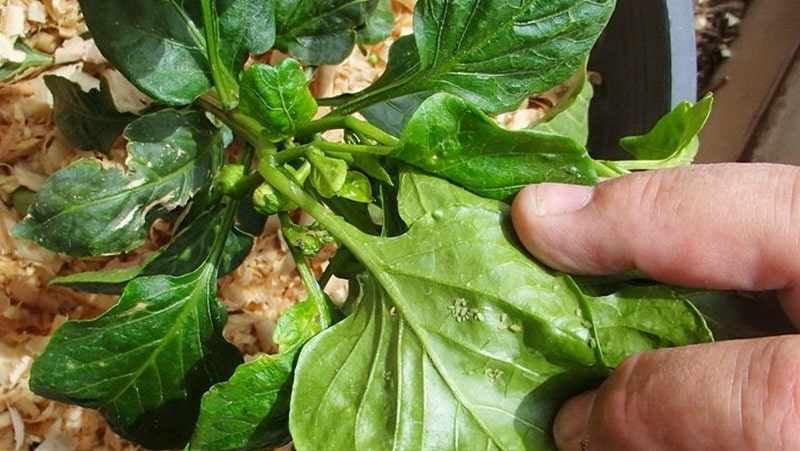
Signs of appearance
Spider mites pierce the skin of pepper leaves and suck out the cell sap. Their saliva contains an enzyme that breaks down cell chloroplasts.
Plants attacked by spider mites look like this:
- the edges of the leaf blades curl, the petioles are deformed;
- dehydrated leaf veins form a marble pattern;
- brown spots appear on the underside of the leaves, after a while the leaf dries out and falls off;
- the buds fade;
- growth slows down;
- a cobweb is visible on the bottom of the leaf (colonies primarily settle there);
- As the pest continues to multiply, the plants become completely covered with cobwebs; a mass of moving mites is visible to the naked eye at the tips of the shoots.
Routes of infection
Infection of peppers can occur in several ways:
- The tick is carried by the wind on its web;
- the parasite can enter the garden on clothes, shoes or animal fur;
- crawls from infected plants to nearby healthy plants.
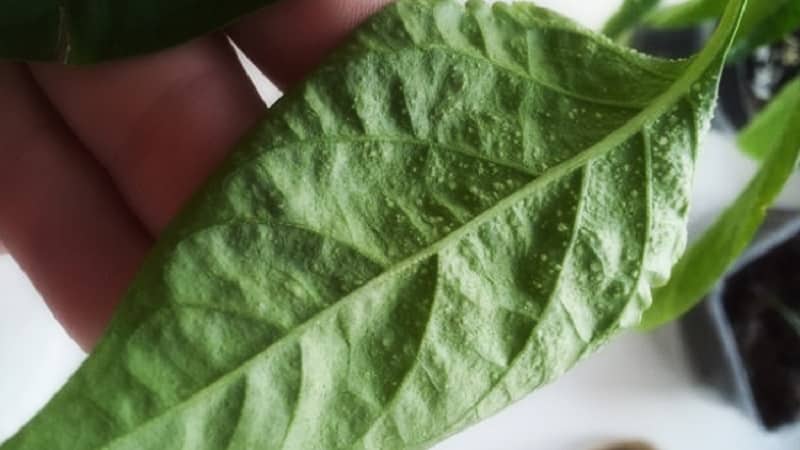
Spider mites on pepper seedlings
On pepper seedlings, spider mites are almost invisible at the early stage of infection. In order to take preventive measures in time and notice the problem, you need to know the reasons for the appearance of the parasite and the favorable conditions for its existence.
Reasons for appearance
Colonies of spider mites develop when:
- high ambient temperature - mites become active at temperatures of 16-20⁰С, reproduction accelerates when temperatures reach above 25⁰С;
- low humidity - comfortable humidity for the parasite is 40-50%;
- insufficient watering of pepper - when there is a lack of water in plant tissues, the content of soluble carbohydrates increases, which contribute to the proliferation of mites;
- excess nitrogen fertilizing - plants with excess green mass are more attractive to pests.
Damage caused
Spider mites, feeding on pepper juices, interfere with normal metabolic processes and weaken the plant. The web that weaves around the leaves interferes with photosynthesis. Lesions of the epidermis contribute to infection with fungal and viral diseases.
The activity of the pest leads to a significant reduction in yield, and in advanced cases - to the death of plants.
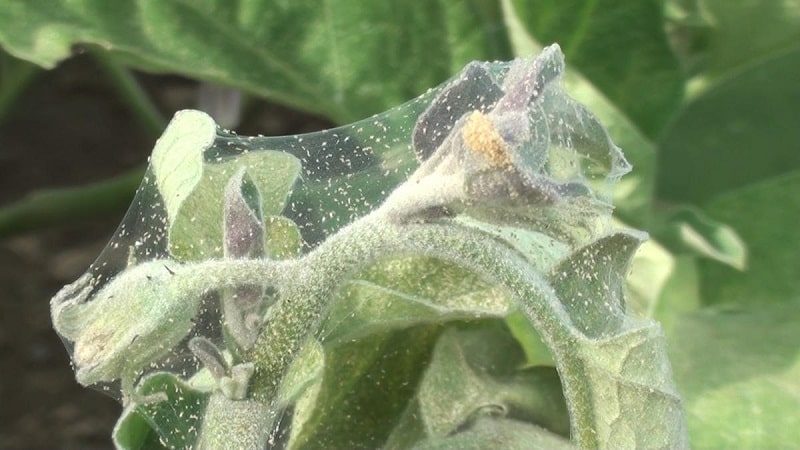
Fighting methods
What to do to remove spider mites? Methodically and regularly treat the beds, especially since the arsenal of means and methods for destroying the parasite is wide.
Biological drugs
The most common biological preparations contain populations of phytosailus (predatory mites) that feed only on spider mites. The product is poured into special applicators that are hung on plant stems. Temperatures of 25-27⁰C and humidity of 60-70% are favorable for beneficial predators, so this method is often used in greenhouses.
Use the drug immediately after purchase, since phytosailus does not live long. You can buy it in garden and garden stores.
Chemicals
To obtain the effect and your own safety, you must use chemicals in strict accordance with the instructions.
Important! Ticks belong to the class of arachnids, so only acaricidal or insectoacaricidal chemicals are suitable for their destruction.
Several drugs have earned a reputation among vegetable growers:
- "Akarin" - acaricide of intestinal contact action, the active substance is avertin-N. 8-16 hours after treatment, ticks stop feeding and moving. "Akarin" does not affect pest eggs. The drug is extremely toxic to bees.
- "Apollo" - narrowly targeted acaricidal agent of contact action, active ingredient clofentezine. Has a detrimental effect on eggs and larvae of spider mites. Adults do not die, but lose the ability to reproduce. The effect of the drug lasts from 30 to 60 days. Safe for beneficial insects and predatory mites.
- "Aktellik" - insectoacaricide of enteric contact action, the active substance is pirimophos-methyl (phosphoranic compound). The protective effect lasts up to ten days. Dangerous for bees.
- "Fitoverm" - insectoacaricide of intestinal contact action, the active substance is aversectin C, leads to paralysis and then death of parasites. Protects plants for up to two weeks. The drug is dangerous for bees.
Spider mites quickly develop resistance to chemicals, so the same product cannot be used repeatedly. Failure to comply with recommended dosages also leads to parasite resistance.
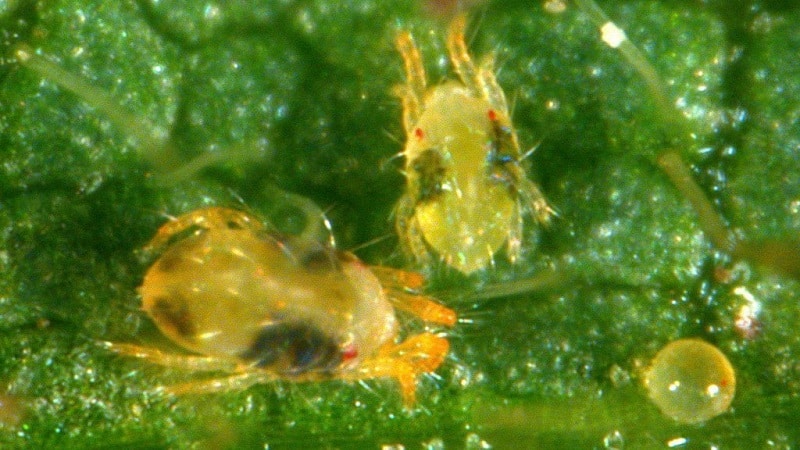
Traditional methods
Folk remedies should be used in the initial stages of infection or during the fruiting period. They are not as effective as chemicals, but they can reduce the number of parasites.
Experienced summer residents advise using the following recipes:
- Dissolve a piece of laundry soap in a bucket of water. Using a sponge, wash the leaves of the plants with the resulting solution.
- Infuse 400 g of dry tobacco or shag in 10 liters of water for a day, then boil and strain. Dissolve 50 g of laundry soap in the cooled broth.Dilute the resulting liquid with water 1:1 and spray the vegetables.
- Chop 500 g of garlic and add three liters of water. Leave for 5 days in the dark. To process peppers, 60 ml of the resulting extract is diluted in a bucket of water and 50 g of grated soap is added.
Agrotechnical techniques
Agrotechnical measures to combat spider mites include:
- deep autumn digging of beds - contributes to the death of parasites from low temperatures in winter;
- treating the soil in greenhouses in the spring with sulfur bombs - to destroy dormant pests;
- the distance between the beds should be at least 80-90 cm - this will limit the spread of the parasite to healthy plants;
- crop rotation - replacing crops in the garden: for example, next year you can plant peppers in place of tomatoes, on which ticks do not live;
- thorough weeding - so that in early spring female mites have no place to develop;
- reasonable fertilizing with nitrogen fertilizers - excess nitrogen leads to accelerated reproduction of pests;
- planting varieties resistant to spider mite.
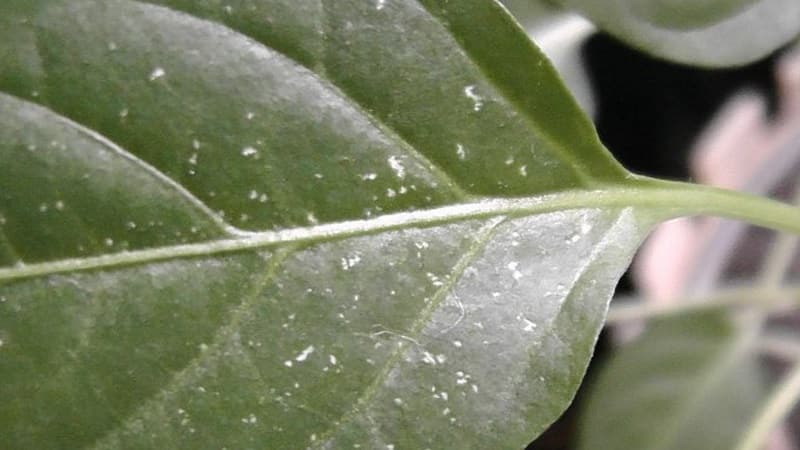
Rules for processing pepper seedlings
It is recommended to process seedlings at a temperature not lower than 18⁰C, otherwise the effectiveness of most products is reduced. It is better to carry out work on a clear, windless day in the late morning, when the dew has dried.
Spraying with chemicals and folk remedies should be carried out in closed clothing, a hat, a respirator, glasses, and gloves. The presence of children and animals on the site at this time is unacceptable.
The nuances of fighting in a greenhouse and in open ground
Measures to combat spider mites in a greenhouse and in open ground are similar.
However, the limited space of greenhouses allows pests to spread more quickly. Delay in the fight against mites in a greenhouse threatens crop loss.
Chemicals should be used indoors with caution. After treatment, it is not recommended to enter the room for 24 hours.
Preventive measures
To save time and money, it is better to take the following preventive measures in time:
- In the fall, remove all fallen leaves and plant debris from the garden.
- Dig up the soil and treat with an acaricide.
- Remove all weeds in a timely manner.
- Carry out regular watering.
- Carry out preventive spraying with acaricidal chemicals or folk remedies.
- Maintain humidity in the greenhouse at 60-70% and temperature up to 25⁰C (these conditions are unfavorable for the reproduction of spider mites).
- At the end of the season, wash and disinfect the greenhouse, remove plant debris, treat the soil with sulfur bombs.
- Plant peppers next to garlic and onions, since tetranych mites avoid them.
Tips and tricks
A few recommendations from experienced gardeners.
- If small parts of plants are affected, they must be removed immediately along with the parasites. There will be no great harm to the pepper, but the spread of the mite will be significantly reduced.
- At the initial stage of infection, you can manually remove the parasites or wash them off with soap and water.
- To increase resistance to parasites, you need to increase the immunity of peppers. For this purpose, stimulants are used, for example, “Immunocytophyte”, “Carvitol”.
- Foliar phosphorus-potassium fertilizers increase resistance to mite infestation.
Conclusion
Spider mites are a real disaster for peppers. A small tick, invisible to the naked eye, is difficult to notice immediately. Slowing growth, the appearance of brown spots and cobwebs on the leaves already signal serious damage to the plant. But don't give up.Vegetable growers have enough means of control in their arsenal: biological chemicals, folk recipes and, most importantly, correct agricultural technology.